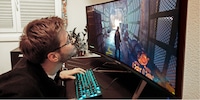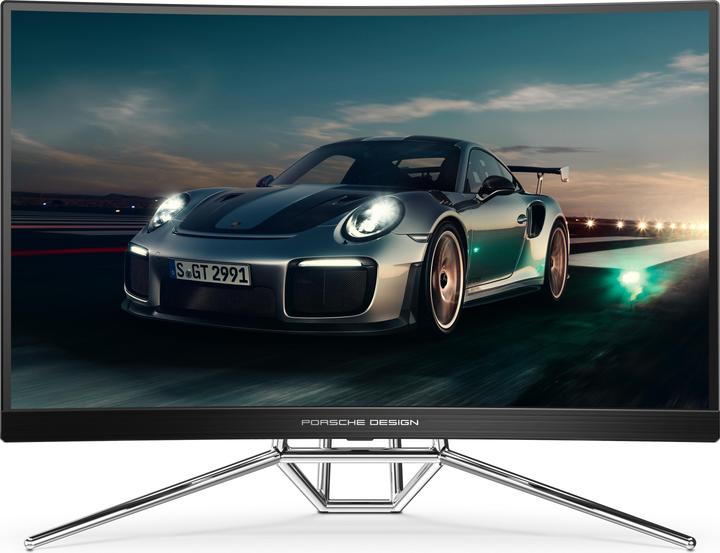

AOC Porsche Design PD27: stylish but expensive
AOC lets Porsche Design be the driving force behind the look of its new monitor. The result is a slightly more expensive but also more stylish piece of kit, the AOC Porsche Design PD27.
A fancy black cardboard box is waiting for me in the entrance hall. I can barely contain myself, because inside the box is the test model of the PD27. Before it even arrived, I was able to watch a video on the new offering from AOC and Porsche Design. Packed with more than enough marketing spiel, obviously. In actual fact, I can't even remember any of that stuff. The only thing that stuck in my head was the monitor design, which is meant to have the same feel as the streamlined fast cars from Stuttgart. OK, so maybe I did subconsciously take on some of the marketing guff. Either way, the device looks fantastic. And I'm not even a petrolhead let alone a Porsche fan.
Design and what's in the box
Rather than being wrapped in the usual polystyrene, the premounted, velvety smooth monitor is in stylish, anthracite-coloured polyethylene foam. On top is a black cardboard box bearing the Porsche Design and Agon logos. The manufacturers are making a statement with the packaging layer alone. In other words, make way, this is exclusive. The unboxing experience continues. Once you open the cardboard box, you're met with a USB stick that's been specially designed for the monitor, laid out on a black cover sheet. The rest of the equipment is in smaller black boxes under this.
It's exciting the way the manufacturers celebrate the special moment that is the unboxing process. They turn it into a real experience. Not that that's anything new. Almost all manufacturers want to make unboxing into an experience in order to emphasise how exclusive their products are. Apple takes the crown in that game. I, on the other hand, usually find the whole unboxing paraphernalia over the top and even embarrassing. But with the PD27, I let myself get taken in by it. By the time I unbox the completely excessive remote, I'm smitten. The «wireless gaming keypad» is based on the centre console of Porsche sports cars. It's ludicrous for a monitor control, which somehow makes it infinitely cool.
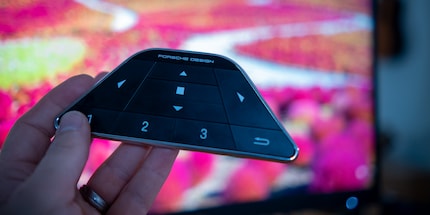
What's less cool is unboxing the brick masquerading as the external power supply. At 16×7×4 cm, it's huge.
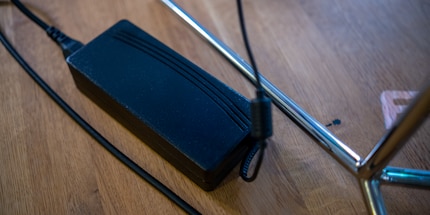
They probably didn't have space for it in the monitor. It's a shame as Carreras have their motor in the rear rather than externally. What's included at a glance:
- Fancily designed USB device
- OSD keypad controller fashioned in a ludicrously fancy design
- Fancily designed setup guide and other pointless paperwork
- External power supply featuring brick design
- HDMI, DisplayPort and USB cable (each 1.8 m)
- Speaker cable for the integrated speakers
What with all the flashy bits and bobs, I almost forgot the most important part, the monitor. The metal base is an eye catcher and reminiscent of a roll bar. Meanwhile, the 1000R curvature adopts the round shape of Porsche, and the almost borderless bezel design on three sides adds a sleek look. I think the design is a roaring success. It actually reminds me of a Porsche sports car.

The monitor and base are well made – nothing shakes or creaks. The frame might be plastic, but it doesn't look or feel it. At the bottom of the front side, it has a brushed aluminium look. The monitor tilts, swivels and is height adjustable. Ergonomically, everything is great. Except you can't really hide the cables.
But the roll-bar base does have its drawbacks. At 32.5 cm, it's pretty broad. This means you're unlikely to find space for the PD27 on a narrow desk.
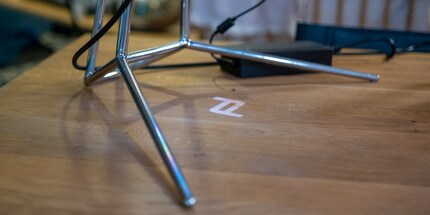
Features and performance
The PD27 comes in at almost 800 Swiss francs. The design alone doesn't justify this high price. So it's up to the monitor and specs to pull out all the stops. It's safe to say the specs speak for themselves:
- Resolution, size and aspect ratio: 2560×1440 (WQHD) over 27 inches in a 16:9 format.
- Curved: 1000R curvature
- Screen technology: VA
- Refresh rate: 240 Hz
- Response time (grey to grey): 0.5 ms
- Brightness: 550 cd/m2.
- Vesa Certified DisplayHDR 400
- Colour space coverage: sRGB 119
- Freesync Premium Pro, Freesync 2
These features make the PD27 comparable with the Samsung Odyssey G7. While the AOC delivers slightly more in terms of brightness, the Samsung is certified DisplayHDR 600. Samsung also offers G-Sync, but the AOC monitor has the shorter reaction time of 0.5 ms.

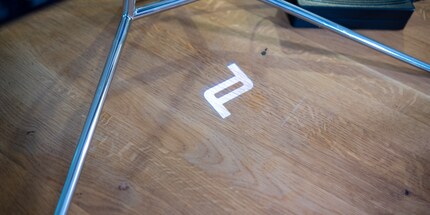
The monitor also includes 5 W DTS stereo speakers and the following ports: 1× 4-port USB-3.2 hub, 2× HDMI 2.0 and 2× DisplayPort 1.4. There's no USB-C. In terms of lighting, Porsche Design and AOC came up with something special. They included a projector on the bottom of the base that shines the Porsche Design and Agon logos onto your desk. The base also includes RGB LEDs that can be configured using the OSD. And there's an LGB bar on the bottom front of the display.
Display and image quality
First of all, I used the Eizo monitor test to get an idea of the quality. As you would expect from a monitor in this price range, I didn't notice any pixel errors. The image was homogeneous, the colour distances were differentiated and the gradient was even.
The 1000R curvature takes a bit of getting used to. For a 27-inch monitor, it's extreme. But as I have the Samsung G7 27-inch on my test bench, I'm used to it. Personally, I love this curvature. That'll be because I sit really close to the monitor and am reliant on a wide field of view. If that's not the case for your setup, you might want to think twice about getting the PD27.
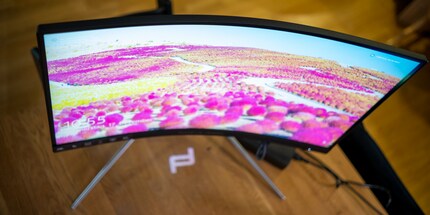
I used the x-rite i1Display Pro spectrometer to measure the PD27. I found that the monitor is very evenly illuminated on the whole. The brightest areas were in the middle of the monitor. Towards the bottom, however, the brightness decreases. And it didn't reach the advertised 550 nits even with the brightest settings in the OSD. That's because it only has to reach this maximum value for a split second. It's impossible for me to test that using this method.
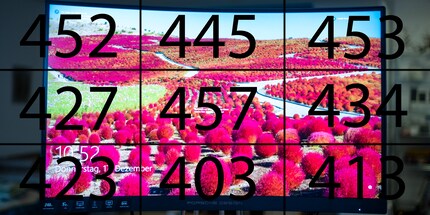
In terms of colour space coverage, the PD27 is convincing. It might not meet the manufacturer value, but it comes very close to it. In all fairness, I have to say I've never reached the manufacturer value on any monitor. That's down to the test method. Manufacturers determine the values in a lab; I work them out in the office. For a 240 Hz VA panel, the values are very good. And if you're an ambitious hobby designer, you'll appreciate the display.
- 99.7% sRGB.
- 82.6% Adobe RGB.
- 87.7% DCI P3.
The static contrast is around 2040:1. You can see backlight bleeding in the corners, but for a VA panel that's not so unusual. And it's not like I notice it on a daily basis – only on this test image.

For gamers with Nvidia graphics cards, the lack of G-Sync might be a problem. Although the monitor isn't advertised as compatible with G-Sync, I was still able to activate it. My test games ran flawlessly with no screen tearing.
The PD27 is certified HDR400. As it's an entry-level HDR monitor, I wasn't expecting a lot from its HDR capabilities. As it happens, the HDR quality is fine and the colours look stronger, but I can't see a big difference when I turn off HDR.
Thanks to the 240 Hz refresh rate, the image is fluid. I can't spot any smearing. To make the most of the high response time of 0.5 ms, I have to activate boost mode in the overdrive settings. But when you activate this, the image will automatically get darker so you can't see your opponent as well. Once overdrive is set to high, this stops being a problem. As I don't play competitively, that's enough for me. But I can imagine that for professional gamers, where every millisecond counts, that's a no go.
Audio
The two 5 W speakers deliver better sound quality than most other inbuilt display speakers I've heard. So, are the PD27 speakers good? In a word, no. At least, not for my needs. I don't want to use the monitor for watching films, far less listening to music. For the odd Youtube video, the speaker quality is passable.
What's a bit annoying is the boot-up sound when I turn on the monitor. Fortunately, you can deactivate this via the OSD.
Cool OSD
You access the OSD by pressing the joystick on the back right of the monitor. Personally, I’m not a fan of joysticks for setting or adjusting values. However, the PD27 joystick is ergonomically designed so that it doesn't even bother me. You can also access the OSD with the keypad controller that comes with the monitor.
I'm pleasantly surprised the first time I open the OSD. The look is new and fresh. Finally, a change from barren OSDs. They can all take a leaf out of the PD27's book.
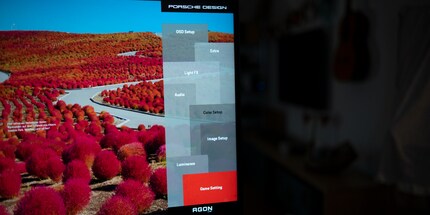
The OSD has eight main elements: OSD setup, extras, light FX, audio, colour settings, image settings, brightness and game settings. When you open each of these points, you'll find even more setting options. But I won't go into those in detail. There's just so much. Whether you're looking for RGB, logo projector, colour or game settings, the OSD leaves nothing to be desired.
Verdict: good monitor, you pay extra for the design
The PD27 does almost everything well, but it doesn't do anything perfect. Apart from design – if the monitor is to your taste.
Its colour precision is good but not good enough for professionals.
Similarly, its performance in gaming is good but not good enough for gaming pros.
Meanwhile, its HDR performance is OK, but I can't really spot a huge difference between HDR and SDR.
You can see where I'm going with this. More than anything, the PD27 is for casual gamers or ambitious but non-professional designers and graphic designers who've fallen in love with the monitor.
There's no denying you have to really love the look of the PD27 when it's going to set you back almost 800 francs. It's not exactly small change. Samsung's G7, on the other hand, offers similar specs and costs about 150 francs less (accurate on 16 December 2020). If you want to splash out that much on a monitor, you'll be getting a machine that doesn't do anything wrong but also doesn't do anything 100% right.

From big data to big brother, Cyborgs to Sci-Fi. All aspects of technology and society fascinate me.

